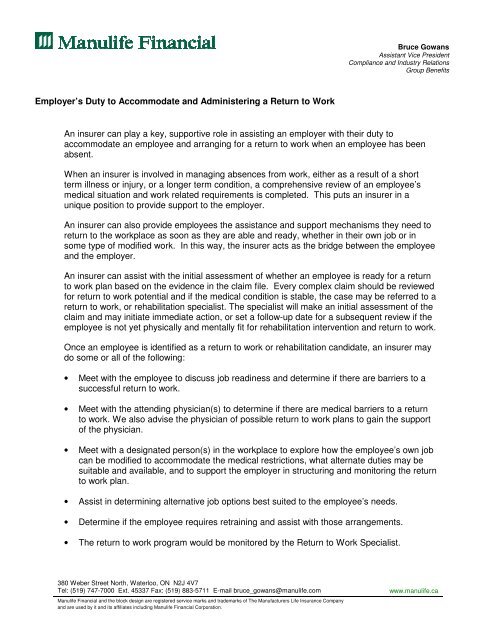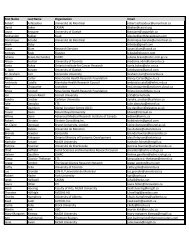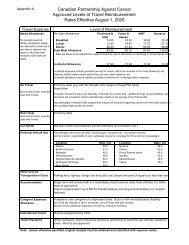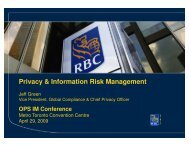Employer's Duty to Accommodate and Administering a Return to ...
Employer's Duty to Accommodate and Administering a Return to ...
Employer's Duty to Accommodate and Administering a Return to ...
Create successful ePaper yourself
Turn your PDF publications into a flip-book with our unique Google optimized e-Paper software.
Bruce GowansAssistant Vice PresidentCompliance <strong>and</strong> Industry RelationsGroup BenefitsEmployer’s <strong>Duty</strong> <strong>to</strong> <strong>Accommodate</strong> <strong>and</strong> <strong>Administering</strong> a <strong>Return</strong> <strong>to</strong> WorkAn insurer can play a key, supportive role in assisting an employer with their duty <strong>to</strong>accommodate an employee <strong>and</strong> arranging for a return <strong>to</strong> work when an employee has beenabsent.When an insurer is involved in managing absences from work, either as a result of a shortterm illness or injury, or a longer term condition, a comprehensive review of an employee’smedical situation <strong>and</strong> work related requirements is completed. This puts an insurer in aunique position <strong>to</strong> provide support <strong>to</strong> the employer.An insurer can also provide employees the assistance <strong>and</strong> support mechanisms they need <strong>to</strong>return <strong>to</strong> the workplace as soon as they are able <strong>and</strong> ready, whether in their own job or insome type of modified work. In this way, the insurer acts as the bridge between the employee<strong>and</strong> the employer.An insurer can assist with the initial assessment of whether an employee is ready for a return<strong>to</strong> work plan based on the evidence in the claim file. Every complex claim should be reviewedfor return <strong>to</strong> work potential <strong>and</strong> if the medical condition is stable, the case may be referred <strong>to</strong> areturn <strong>to</strong> work, or rehabilitation specialist. The specialist will make an initial assessment of theclaim <strong>and</strong> may initiate immediate action, or set a follow-up date for a subsequent review if theemployee is not yet physically <strong>and</strong> mentally fit for rehabilitation intervention <strong>and</strong> return <strong>to</strong> work.Once an employee is identified as a return <strong>to</strong> work or rehabilitation c<strong>and</strong>idate, an insurer maydo some or all of the following:• Meet with the employee <strong>to</strong> discuss job readiness <strong>and</strong> determine if there are barriers <strong>to</strong> asuccessful return <strong>to</strong> work.• Meet with the attending physician(s) <strong>to</strong> determine if there are medical barriers <strong>to</strong> a return<strong>to</strong> work. We also advise the physician of possible return <strong>to</strong> work plans <strong>to</strong> gain the suppor<strong>to</strong>f the physician.• Meet with a designated person(s) in the workplace <strong>to</strong> explore how the employee’s own jobcan be modified <strong>to</strong> accommodate the medical restrictions, what alternate duties may besuitable <strong>and</strong> available, <strong>and</strong> <strong>to</strong> support the employer in structuring <strong>and</strong> moni<strong>to</strong>ring the return<strong>to</strong> work plan.• Assist in determining alternative job options best suited <strong>to</strong> the employee’s needs.• Determine if the employee requires retraining <strong>and</strong> assist with those arrangements.• The return <strong>to</strong> work program would be moni<strong>to</strong>red by the <strong>Return</strong> <strong>to</strong> Work Specialist.380 Weber Street North, Waterloo, ON N2J 4V7Tel: (519) 747-7000 Ext. 45337 Fax: (519) 883-5711 E-mail bruce_gowans@manulife.comManulife Financial <strong>and</strong> the block design are registered service marks <strong>and</strong> trademarks of The Manufacturers Life Insurance Company<strong>and</strong> are used by it <strong>and</strong> its affiliates including Manulife Financial Corporation.www.manulife.ca
In assisting the employee, an insurer looks for opportunities <strong>to</strong> link the employee with existingresources such as an Employee Assistance Program or other appropriate community supportnetworks when required by the employee <strong>to</strong> gain <strong>and</strong> maintain focus on a return <strong>to</strong> productivework.As part of the assessment of an absence, the insurer ensures that all medical <strong>and</strong> nonmedicalissues have been fully investigated <strong>and</strong> determines if treatment is appropriate <strong>to</strong> theidentified condition(s). Sometimes there is opportunity <strong>to</strong> support the employee by gaining anearlier assessment or treatment intervention that will avoid delays that might negatively impactthe employee’s health <strong>and</strong> thereby promote quicker return <strong>to</strong> health <strong>and</strong> productivity.In addition <strong>to</strong> promoting evidence-based, outcome-focused treatment as part of our casemanagement, we also ensure that non-medical barriers are dealt with by identifying <strong>and</strong>solving the underlying root problem <strong>and</strong> ensuring long-term measures are put in place <strong>to</strong>ensure that the root cause has been dealt with <strong>and</strong> will thereby not trigger recurrent absences.This may lead <strong>to</strong> a mediation or facilitation type of role.Many absences from work can include, <strong>and</strong> be exacerbated by workplace conflict,performance or other non-medical issues. These must be dealt with in order <strong>to</strong> successfullyreturn an employee <strong>to</strong> work. This aspect of case management can be delivered in a coupletypes of cases:• It is delivered as a vital part of short term absence management programs in whichwe’re identifying <strong>and</strong> resolving return <strong>to</strong> work barriers <strong>and</strong> where there may not be anunderlying disability.• It can also be delivered as part of disability claims management when there is acombination of medical <strong>and</strong> non-medical barriers interfering with the employee’s return<strong>to</strong> work.Here are two case studies dealing with return <strong>to</strong> work.Case #1 – Mental HealthDiagnosisDepressionSituation • Employee was absent from work with depression for one week at referral.• Receiving treatment in the form of medication.• Case Manager discovered that a number of issues contributed <strong>to</strong> the employee'sabsence from work including workplace fac<strong>to</strong>rs including a communication breakdownbetween the employee <strong>and</strong> the employer that created increasing levels of anxiety <strong>and</strong>ultimately resulted in the workplace absence.Intervention • The <strong>Return</strong> <strong>to</strong> Work Specialist investigated the workplace issues, confirming fac<strong>to</strong>rs <strong>to</strong>be:• the employee had recently moved <strong>to</strong> a new role within the company,• struggled through the training <strong>and</strong>• did not meet performance expectations• The <strong>Return</strong> <strong>to</strong> Work Specialist negotiated an agreeable resolution with the employee<strong>and</strong> employer, coordinating a graduated return <strong>to</strong> work plan that incorporated additional380 Weber Street North, Waterloo, ON N2J 4V7Tel: (519) 747-7000 Ext. 45337 Fax: (519) 883-5711 E-mail bruce_gowans@manulife.comwww.manulife.caManulife Financial <strong>and</strong> the block design are registered service marks <strong>and</strong> trademarks of The Manufacturers Life Insurance Company<strong>and</strong> are used by it <strong>and</strong> its affiliates including Manulife Financial Corporation.
technical training.• A men<strong>to</strong>r was assigned <strong>to</strong> the employee <strong>to</strong> answer any questions <strong>and</strong> help <strong>to</strong> problemsolve if the employee ran in<strong>to</strong> problems.• The employee ultimately resumed regular duties.Value • Early re-entry in<strong>to</strong> the workplace through resolution of interpersonal issues betweenemployee <strong>and</strong> employer, effective training, a graduated return <strong>to</strong> work developed <strong>to</strong>meet the needs of the employee (gradually reintegrate in<strong>to</strong> the workplace, build up<strong>to</strong>lerance, stamina <strong>and</strong> cognitive capacity) <strong>and</strong> the manager (able <strong>to</strong> meet staffscheduling <strong>and</strong> cus<strong>to</strong>mer services requirements).• Early return <strong>to</strong> work also benefits the employee's recovery - as work is a normal part ofdaily life <strong>and</strong> regular routine can promote recovery.• Without this intervention, the employee could have remained off work for an extendedperiod of time, receiving only symp<strong>to</strong>m-focused treatment <strong>and</strong> the underlying issuesmay never have been addressed <strong>and</strong> resolved, resulting in a longer term claim.Instead, the employee achieved a shortened duration of absence <strong>and</strong> the employer’sabsence costs were contained.Case #2 – Physical HealthDiagnosisLower back surgerySituation • Employee works in an office setting at a desk all day.• Was recovering from lower back surgery for a herniated disc <strong>and</strong> had limited<strong>to</strong>lerance for sustained sitting/st<strong>and</strong>ing.• Employee had <strong>to</strong> attend physiotherapy 3 days per week for 8 more weeks <strong>and</strong>perform 15 minutes of exercises mid-day every day.Intervention • The <strong>Return</strong> <strong>to</strong> Work Specialist worked with the manager <strong>and</strong> employee <strong>to</strong> develop agraduated plan that accommodated sitting <strong>to</strong>lerance limitations (employee was givenaccess <strong>to</strong> a sit/st<strong>and</strong> workstation <strong>and</strong> could vary work activities such that he didn’thave <strong>to</strong> sustain the same position for long periods) <strong>and</strong> documented the plan for allparties.• A graduated return-<strong>to</strong>-work plan was developed <strong>to</strong> allow the employee <strong>to</strong> attend hisphysiotherapy - either before or after he started work.• The <strong>Return</strong> <strong>to</strong> Work Specialist assisted the employee in negotiating with the manager<strong>to</strong> provide the employee with space <strong>to</strong> perform his daily exercises at work.Value • Early re-entry in<strong>to</strong> the workplace through a graduated return <strong>to</strong> work developed <strong>to</strong>meet the needs of the employee (build up <strong>to</strong>lerance, stamina <strong>and</strong> functional capacity<strong>and</strong> reduction of risk of recurring absence due <strong>to</strong> the lower back problem) <strong>and</strong> themanager (i.e. scheduling, requirements <strong>to</strong> service cus<strong>to</strong>mers, etc).• Early return <strong>to</strong> work was beneficial for this employee as activity promotes effectiverecovery from surgery.• Management of health risks reduces chance of further injury <strong>to</strong> the employee <strong>and</strong>more lost time from workplace. This in turn helps the employer <strong>to</strong> be supportive of itsemployees while shortening duration of absences <strong>and</strong> containing absence costs.An employee’s disability may be more sever or complex. In this case, an insurer engages in alonger-term intervention requiring a series of meetings with the employee, employer <strong>and</strong>380 Weber Street North, Waterloo, ON N2J 4V7Tel: (519) 747-7000 Ext. 45337 Fax: (519) 883-5711 E-mail bruce_gowans@manulife.comManulife Financial <strong>and</strong> the block design are registered service marks <strong>and</strong> trademarks of The Manufacturers Life Insurance Company<strong>and</strong> are used by it <strong>and</strong> its affiliates including Manulife Financial Corporation.www.manulife.ca
elevant health care providers <strong>to</strong> identify <strong>and</strong> then resolve functional impairments in order <strong>to</strong>enable the employee’s return <strong>to</strong> work with the pre-disability employer.The assessment may incorporate any or all of the following measures in order <strong>to</strong> expeditesafe, efficient return <strong>to</strong> work as early as medically possible:• assess cognitive or physical function;• evaluate worksite ergonomics (e.g., workstation set-up, production sequencing);• facilitate treatment, identifying treatment options <strong>and</strong> facilitating referrals <strong>to</strong> health careproviders when appropriate <strong>to</strong> confirm medical impairment, <strong>to</strong> promote recovery ofhealth, <strong>to</strong> improve function;• develop, implement <strong>and</strong> moni<strong>to</strong>r return <strong>to</strong> work programsHere are two case studies involving a more complex return <strong>to</strong> work program.Case # 3 – Mental HealthDiagnosisDepressionSituation • Employee was off work with depression.• Followed by a family doc<strong>to</strong>r as well as a Psychiatrist <strong>and</strong> was receiving medication.Intervention • The Functional Rehabilitation Specialist met with the employee at home <strong>to</strong> perform aninitial assessment interview.• The assessment identified that the employee was not making progress as expecteddespite increasing dosages of anti-depressant medications.• Through the interview process the Functional Rehabilitation Specialist was able <strong>to</strong>identify that the employee had multiple stressors - family (a parent with declininghealth <strong>and</strong> a troubled marriage), work (difficulty coping with work dem<strong>and</strong>s) <strong>and</strong> hadalways struggled with balancing the multiple dem<strong>and</strong>s of day-<strong>to</strong>-day life.• The Functional Rehabilitation Specialist expedited a referral <strong>to</strong> a Psychologist trainedin Cognitive Behavioural Therapy techniques with whom the employee developed the<strong>to</strong>ols necessary <strong>to</strong> proactively deal with life stressors <strong>and</strong> became better able <strong>to</strong> copewith her situation.• The Functional Rehabilitation Specialist then worked with the family doc<strong>to</strong>r,Psychiatrist <strong>and</strong> Psychologist <strong>to</strong> facilitate re-entry in<strong>to</strong> the workplace ensuring that theemployee was able <strong>to</strong> sustain health <strong>and</strong> work.Value • The Functional Rehabilitation Specialist was able <strong>to</strong> identify underlying contribu<strong>to</strong>rs <strong>to</strong>the employee’s depressive symp<strong>to</strong>ms <strong>and</strong> work with the treating physicians <strong>to</strong>augment treatment focused on improving cognitive <strong>and</strong> emotional coping capacity.• Had the underlying risk fac<strong>to</strong>rs been left unaddressed, the employee’s symp<strong>to</strong>ms mayhave persisted despite the treatment <strong>and</strong> the claim would have extended.• Instead, an earlier return <strong>to</strong> work helped <strong>to</strong> promote effective recovery of theemployee’s health <strong>and</strong> productivity, resulting in a shorter duration of absence.Case #4 – Physical Health380 Weber Street North, Waterloo, ON N2J 4V7Tel: (519) 747-7000 Ext. 45337 Fax: (519) 883-5711 E-mail bruce_gowans@manulife.comManulife Financial <strong>and</strong> the block design are registered service marks <strong>and</strong> trademarks of The Manufacturers Life Insurance Company<strong>and</strong> are used by it <strong>and</strong> its affiliates including Manulife Financial Corporation.www.manulife.ca
DiagnosisCoronary Artery DiseaseSituation • Employee had coronary artery bypass surgery <strong>and</strong> was recovering.• His job as a maintenance engineer in a warehouse had light <strong>to</strong> medium physicaldem<strong>and</strong>s.Intervention • The Functional Rehabilitation Specialist met with the family doc<strong>to</strong>r <strong>to</strong> discussrehabilitation options for the employee.• Through this meeting it was determined that a multidisciplinary cardiac rehabilitationprogram including education, exercise, nutrition <strong>and</strong> prevention was required.• The Functional Rehabilitation Specialist expedited a referral <strong>to</strong> an appropriaterehabilitation program <strong>and</strong> then assisted the employee in negotiating modified duties<strong>to</strong> facilitate an early re-entry in<strong>to</strong> the workplace in an accommodated capacity (theemployee performed sedentary work <strong>to</strong> start, gradually increasing <strong>to</strong> his normal jobdem<strong>and</strong>s as he progressed through the cardiac rehabilitation program).Value • The Functional Rehabilitation Specialist facilitated getting the employee in<strong>to</strong> the rehabprogram <strong>and</strong> then matched <strong>and</strong> moni<strong>to</strong>red it with the return <strong>to</strong> work.• The Functional Rehabilitation Specialist was able <strong>to</strong> increase the employee’s workdem<strong>and</strong>s based on progress in the cardiac rehab program - such that the workplacewas part of his rehabilitation <strong>and</strong> reconditioning <strong>and</strong> the employee was kept safe.• This kind of return <strong>to</strong> work program is typically about 8-12 weeks but ensures theemployee recovers fully <strong>and</strong> reintegrates safely <strong>to</strong> the workplace.Drug <strong>and</strong> Alcohol TestingInsurers are not involved with drug or alcohol testing at the pre-employment stage. Nor arethey involved with periodic testing in the workplace. However, an insurer may becomeinvolved when drug or alcohol abuse has become serious enough <strong>to</strong> cause an absence fromthe workplace.Most disability insurance contracts include a provision that requires an employee <strong>to</strong> be undermedical care that is appropriate <strong>to</strong> the condition causing disability. In some cases, a contractmay specifically require participation in an in-patient treatment program for drug or alcoholabuse for benefits <strong>to</strong> be payable. The insurer reserves the right <strong>to</strong> determine whether anygiven treatment is appropriate.This approach creates an incentive (payment of the disability benefits) for the employee <strong>to</strong>participate in a treatment program that will help them with their abuse <strong>and</strong> ultimately allow theemployee <strong>to</strong> return <strong>to</strong> the workplace.Privacy Legislation Across CanadaFor companies that operate across Canada, or in varying industries, there is a range oflegislation that must be considered. Privacy policies must meet the test in all of thejurisdictions in which a company operates.Private Sec<strong>to</strong>r380 Weber Street North, Waterloo, ON N2J 4V7Tel: (519) 747-7000 Ext. 45337 Fax: (519) 883-5711 E-mail bruce_gowans@manulife.comManulife Financial <strong>and</strong> the block design are registered service marks <strong>and</strong> trademarks of The Manufacturers Life Insurance Company<strong>and</strong> are used by it <strong>and</strong> its affiliates including Manulife Financial Corporation.www.manulife.ca
Businesses that operate in the private sec<strong>to</strong>r generally need <strong>to</strong> comply with PIPEDA, orsubstantially similar provincial legislation. At present, Quebec (Act respecting the Protectionof Personal Information in the Private Sec<strong>to</strong>r), Alberta (Personal Information Protection Act)<strong>and</strong> BC (Personal Information Protection Act) are the only provinces with substantially similarlegislation. All other provinces will be governed by PIPEDA.Fortunately, these acts are “similar”. An organization that operates in all jurisdictions wouldtypically provide direction <strong>to</strong> staff that meets the highest level from all provinces. However,when dealing with a complaint or other inquiry, the processes, or legislative references will bedifferent.Public Sec<strong>to</strong>rProtection of personal information held or controlled by public sec<strong>to</strong>r organizations isgoverned by forms of Freedom of Information <strong>and</strong> Protection of Privacy legislation in theprovinces. BC, Alberta, Saskatchewan, Mani<strong>to</strong>ba, Ontario, PEI <strong>and</strong> Nova Scotia havelegislation entitled Freedom of Information <strong>and</strong> Protection of Privacy Act. Ontario also has aMunicipal Freedom of Information <strong>and</strong> Protection of Privacy act <strong>to</strong> govern the actions ofmunicipalities.Newfoundl<strong>and</strong>, Yukon, NWT <strong>and</strong> Nunavut have legislation entitled Access <strong>to</strong> Information <strong>and</strong>Protection of Privacy Act.New Brunswick has the Protection of Personal Information Act. Quebec completes the listwith an Act respecting Access <strong>to</strong> Documents Held by Public Bodies <strong>and</strong> the Protection ofPersonal Information.For Federal works, the Privacy Act is the driving legislation.A private corporation that acts as a service provider <strong>to</strong> a public body, either federal orprovincial, may find that it needs <strong>to</strong> comply with any or all of these acts, in addition <strong>to</strong> PIPEDAthat governs its own business actions.Health InformationSome provinces have enacted specific legislation <strong>to</strong> govern the treatment of healthinformation created <strong>and</strong> retained by health cus<strong>to</strong>dians. These are generally medicalpractitioners who create or collect health related information within their scope of practice.Cus<strong>to</strong>dians will include physicians, pharmacists, nurses, <strong>and</strong> other medical or paramedicalpractitioners. While these acts may not apply directly <strong>to</strong> a private corporation, you can beaffected if you need <strong>to</strong> access that health information for your business. For example, aninsurance company acquires health information when assessing a claim for payment <strong>and</strong> willneed <strong>to</strong> underst<strong>and</strong> the requirements <strong>to</strong> obtain this information within the various acts.Alberta, Saskatchewan, Mani<strong>to</strong>ba <strong>and</strong> Ontario have a form of Health Information ProtectionAct. In other provinces, health information will be captured within the other privacy protectionacts.This patchwork of legislation across the country <strong>and</strong> separation by the nature of the industrycreates a challenge for the privacy professional in organizations that operate in manyjurisdictions.380 Weber Street North, Waterloo, ON N2J 4V7Tel: (519) 747-7000 Ext. 45337 Fax: (519) 883-5711 E-mail bruce_gowans@manulife.comManulife Financial <strong>and</strong> the block design are registered service marks <strong>and</strong> trademarks of The Manufacturers Life Insurance Company<strong>and</strong> are used by it <strong>and</strong> its affiliates including Manulife Financial Corporation.www.manulife.ca
















